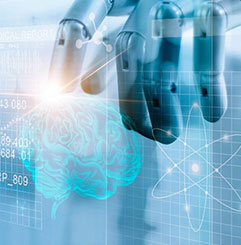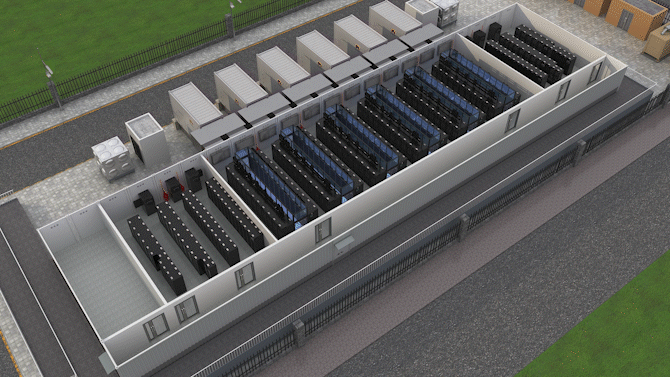China Mobile (Shaanxi) delivers nearly 1000 data center racks within six months and implements natural cooling for 10 months each year with Huawei FusionDC solution
Trends
Carrier industry trends
Following the fast deployment of information infrastructure for 5G, cloud computing, big data, Internet of Things (IoT), and AI, carriers are driving the transformation of the digital economy.
Carriers are capitalizing on their strengths in computing and networking to build secure, green, and low-carbon data centers that deliver high computing power.

Application Scenarios
 Colocation Data Center
Colocation Data Center
Standard data centers built by carriers provide comprehensive B2B services such as server hosting, leasing, and other value-added services.
 ICT Facility
ICT Facility
Equipment rooms accommodate ICT equipment for carriers.
Challenges

High CAPEX and risks
Normally, large data centers are planned and built in one go. The lack of phased deployment results in high CAPEX and risks.

Carbon neutrality
Government policies promote green and sustainable data center development. Regulatory compliance will be a primary consideration in data center construction, capacity expansion, and modernization.

Security and availability
Facilities must be secure and stable to assure the security of data housed in data centers. Plus, service continuity is a top priority for colocation data centers.

Complex construction and O&M
Data centers are growing in scale, managing exponentially more data. Data and services are converging. As a result, it is difficult to operate and maintain the many complex facilities.
Design Principle
- Green: Uses more green energy sources and deploys green power on a larger scale.
- Efficient: Consumes less electricity, water, and other resources.
- Recyclable: Uses technologies for waste heat and material recovery.
 Sustainable
Sustainable
 Simplified
Simplified
- Architecture: Uses innovative designs for buildings and equipment rooms.
- Power supply: Redefines components and links.
- Cooling: Shortens links while boosting efficiency.
- Automated O&M: Goes digital and intelligent.
- Automatic energy efficiency optimization: Enables smart cooling.
- Autonomous operations: Maximizes resource value.
 Autonomous
Autonomous
 Reliable
Reliable
- Proactive security: Prevents faults and closes them quickly.
- Secure architecture: Safeguards everything from components to data centers.
Solutions & Benefits

-
Short TTM, prefabrication, recycling
Prefabricated modular data centers, no building from scratch.
TTM is 6 months instead of 2 years, faster service rollout.
95% prefabricated, 80% of materials can be recycled.
-
Efficient power supply and rack deployment
97.8% end-to-end power supply efficiency.
40% smaller footprint
10-year service life for lithium batteries, taking up three times less space than lead-acid batteries.
Each battery is equipped with an independent fire extinguisher.
-
Optimal PUE, easy delivery and maintenance
The indirect evaporative cooling system capitalizes on natural cooling sources, saving energy and water.
Delivery is twice as fast thanks to the "one system per container" design.
The AI-based cooling system reduces data center energy consumption by 3%–15%.
-
Higher asset utilization and O&M efficiency
Real-time monitoring of one or multiple data centers.
All links are visible, manageable, and controllable.
20% higher utilization of rack, cooling, and power resources.
35% cheaper O&M thanks to AI-based intelligent inspection and predictive maintenance.
Challenges

Carbon neutrality
Government policies promote green and sustainable data center development. Regulatory compliance will be a primary consideration in ICT facility construction, capacity expansion, and modernization.

Security and availability
Facilities must be secure and stable to assure the security of data housed in data centers. Service continuity is a top priority for carriers' service systems.

Complex construction and O&M
ICT facilities are fundamental to carrier network modernization and digital transformation. It is difficult to operate and maintain the many complex facilities.
Design Principle
- Green: Uses more green energy sources including PV and energy storage.
- Efficient: Consumes less electricity, water, and other resources.
- Recyclable: Recovers out-of-service materials.
 Sustainable
Sustainable
 Simplified
Simplified
- Architecture: Uses innovative designs for buildings and equipment rooms.
- Power supply: Redefines components and links.
- Automated O&M: Goes digital and intelligent.
- Automatic energy efficiency optimization: Enables smart cooling.
- Autonomous operations: Maximizes resource value.
 Autonomous
Autonomous
 Reliable
Reliable
- Proactive security: Prevents faults and closes them quickly.
- Secure architecture: Safeguards everything from components to data centers.
Solutions & Benefits

-
High efficiency and density, saving power and space
UPS5000-H: up to 99% efficiency in S-ECO mode and 0 ms transfer.
3 U 100 kVA power modules: half the footprint.
Lithium batteries: 10-year service life, three times less space than lead-acid batteries.
Each battery is equipped with an independent fire extinguisher.
-
Low PUE and high-density deployment
On-demand capacity expansion thanks to the smart modular design.
Annual PUE as low as 1.111 in Beijing.
In-row air conditioners for high-density deployment, delivering close-coupled cooling and using natural cooling sources if equipped with refrigerant pumps.
-
Easy site selection and fast delivery
Pre-installed, integrated, and tested in the factory.
Quick onsite deployment.
Can be deployed anywhere — in factories, warehouses, parking lots, or even on rooftops.
-
Higher asset utilization and O&M efficiency
Real-time monitoring of one or multiple data centers.
All links are visible, manageable, and controllable.
20% higher utilization of rack, cooling, and power resources.
35% cheaper O&M thanks to AI-based intelligent inspection and predictive maintenance.
View Other Industry Solutions


Marketing Materials Center
For more information, please access the Huawei Digital Power Marketing Materials Center.





























